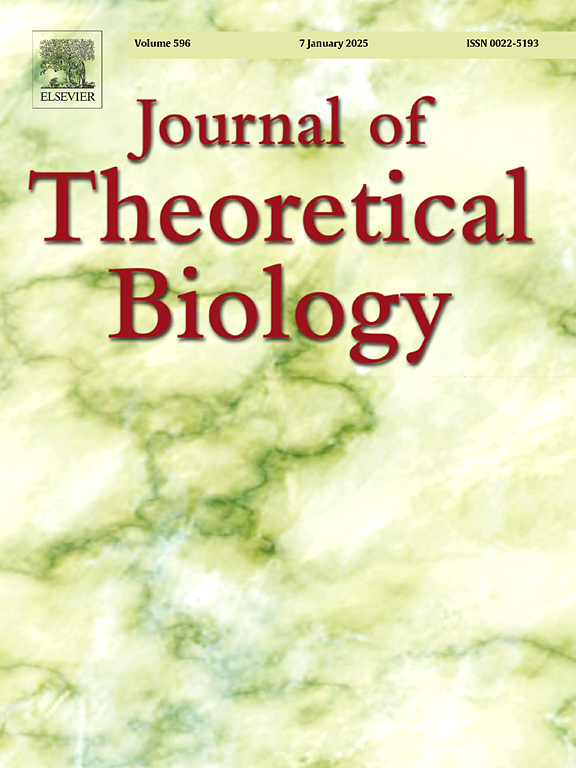The spatial aggregation of phytophagous insects driven by the evolution of preference for plant chemicals
IF 1.9
4区 数学
Q2 BIOLOGY
引用次数: 0
Abstract
Ecologists have shown considerable interest in the spatial patterns of organism distribution and the processes responsible for their formation and maintenance. The phytophagous insects typically use chemicals in plants as host-finding cues. Because nonvolatile chemicals remain near the source, the spatial structure of plant community determines the local distribution of insects. In addition, the plant chemical accumulation due to plant–plant interaction also influences the distribution of insects. In Rumex obtusifolius, for example, the production of phenolics is mediated by conspecific interaction. Rumex plants with high phenolic concentrations are preferred by the leaf beetle Gastrophysa atrocyanea, resulting in its spatial aggregation. Although this preference of beetles for nonvolatile chemicals should be beneficial in finding host plants, there is also a cost in terms of intraspecific competition among the beetles due to aggregation on certain chemical-rich hosts. To investigate the evolutionary significance of preference for nonvolatile chemicals and the ecological consequence of spatial distribution in leaf beetles, we constructed a mathematical model for the joint evolution of two preferences for plant size and chemical condition. In the model, beetles choose a resource based on the size and chemical concentrations of plants and are exposed to resource competition. Host plants accumulate the chemicals when they interact with neighboring conspecifics, and hence the level of chemical accumulation varies depending on the species composition and spatial distribution of the plant community. As a result, beetles became more sensitive to chemicals when the host species was rare and sparsely distributed in the community. The evolution of high chemical preference caused the aggregation of beetles and hence population size declined. We proposed a potential mechanism that underlies aggregated distribution in phytophagous insects, driven by the evolution of chemical preferences in response to plant community structure.
植物化学物质偏好进化驱动的植食性昆虫空间聚集。
生态学家对生物分布的空间格局及其形成和维持过程表现出相当大的兴趣。植食昆虫通常利用植物中的化学物质作为寻找寄主的线索。由于非挥发性化学物质停留在源附近,植物群落的空间结构决定了昆虫的局部分布。此外,植物间相互作用引起的植物化学物质积累也会影响昆虫的分布。例如,在圆叶柳中,酚类物质的产生是由同种相互作用介导的。具有高酚含量的Rumex植物被叶甲虫胃裂藻偏爱,导致其空间聚集。虽然甲虫对非挥发性化学物质的偏好有利于寻找寄主植物,但由于聚集在某些富含化学物质的寄主上,甲虫之间的种内竞争也有代价。为了探讨叶甲虫对非挥发性化学物质偏好的进化意义和空间分布的生态后果,我们构建了叶甲虫对植物大小和化学条件两种偏好联合进化的数学模型。在该模型中,甲虫根据植物的大小和化学物质浓度选择资源,并面临资源竞争。寄主植物在与邻近同种植物相互作用时积累化学物质,因此化学物质积累水平因植物群落的物种组成和空间分布而异。因此,当寄主物种在群落中稀少分布时,甲虫对化学物质更加敏感。高化学偏好的进化导致了甲虫的聚集,从而导致了种群规模的下降。我们提出了一种潜在的机制,该机制是由植物群落结构对化学偏好的进化所驱动的。
本文章由计算机程序翻译,如有差异,请以英文原文为准。
求助全文
约1分钟内获得全文
求助全文
来源期刊
CiteScore
4.20
自引率
5.00%
发文量
218
审稿时长
51 days
期刊介绍:
The Journal of Theoretical Biology is the leading forum for theoretical perspectives that give insight into biological processes. It covers a very wide range of topics and is of interest to biologists in many areas of research, including:
• Brain and Neuroscience
• Cancer Growth and Treatment
• Cell Biology
• Developmental Biology
• Ecology
• Evolution
• Immunology,
• Infectious and non-infectious Diseases,
• Mathematical, Computational, Biophysical and Statistical Modeling
• Microbiology, Molecular Biology, and Biochemistry
• Networks and Complex Systems
• Physiology
• Pharmacodynamics
• Animal Behavior and Game Theory
Acceptable papers are those that bear significant importance on the biology per se being presented, and not on the mathematical analysis. Papers that include some data or experimental material bearing on theory will be considered, including those that contain comparative study, statistical data analysis, mathematical proof, computer simulations, experiments, field observations, or even philosophical arguments, which are all methods to support or reject theoretical ideas. However, there should be a concerted effort to make papers intelligible to biologists in the chosen field.

 求助内容:
求助内容: 应助结果提醒方式:
应助结果提醒方式:


